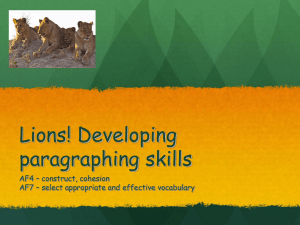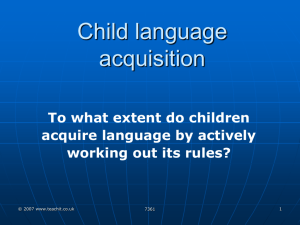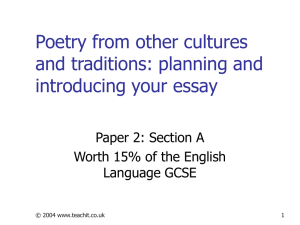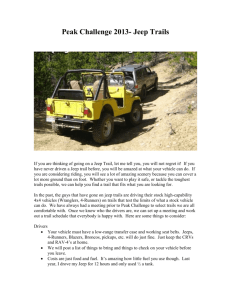Pick`n`mix / flow chart approach
advertisement
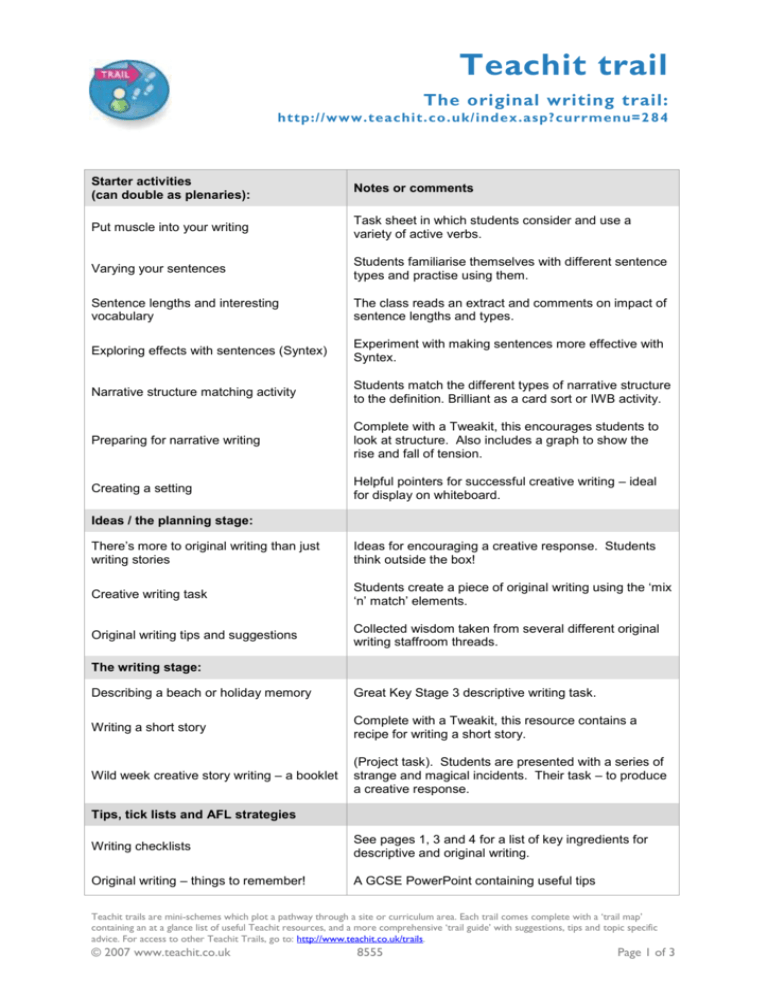
Teachit trail The original writing trail: http://www.teachit.co.uk/index.asp?currmenu=2 84 Starter activities (can double as plenaries): Notes or comments Put muscle into your writing Task sheet in which students consider and use a variety of active verbs. Varying your sentences Students familiarise themselves with different sentence types and practise using them. Sentence lengths and interesting vocabulary The class reads an extract and comments on impact of sentence lengths and types. Exploring effects with sentences (Syntex) Experiment with making sentences more effective with Syntex. Narrative structure matching activity Students match the different types of narrative structure to the definition. Brilliant as a card sort or IWB activity. Preparing for narrative writing Complete with a Tweakit, this encourages students to look at structure. Also includes a graph to show the rise and fall of tension. Creating a setting Helpful pointers for successful creative writing – ideal for display on whiteboard. Ideas / the planning stage: There’s more to original writing than just writing stories Ideas for encouraging a creative response. Students think outside the box! Creative writing task Students create a piece of original writing using the ‘mix ‘n’ match’ elements. Original writing tips and suggestions Collected wisdom taken from several different original writing staffroom threads. The writing stage: Describing a beach or holiday memory Great Key Stage 3 descriptive writing task. Writing a short story Complete with a Tweakit, this resource contains a recipe for writing a short story. Wild week creative story writing – a booklet (Project task). Students are presented with a series of strange and magical incidents. Their task – to produce a creative response. Tips, tick lists and AFL strategies Writing checklists See pages 1, 3 and 4 for a list of key ingredients for descriptive and original writing. Original writing – things to remember! A GCSE PowerPoint containing useful tips Teachit trails are mini-schemes which plot a pathway through a site or curriculum area. Each trail comes complete with a ‘trail map’ containing an at a glance list of useful Teachit resources, and a more comprehensive ‘trail guide’ with suggestions, tips and topic specific advice. For access to other Teachit Trails, go to: http://www.teachit.co.uk/trails. © 2007 www.teachit.co.uk 8555 Page 1 of 3 Original writing trail This trail incorporates a range of original writing tasks and approaches so that you can pick and choose your activities according to the key stage or exact needs of a group/individual. The selected resources range from specific tasks on sentences and vocabulary, to more wide ranging activities or ideas geared towards getting your students’ creative juices flowing. Getting going Put muscle into your writing by using strong verbs. This is a good, rowdy starter in which students are encouraged to think about specific verb choices and act them out. Then it’s onto the nitty gritty of replacing the verbs with their own selections. Stretch this resource by getting students to take a ploddy passage from a text and jazz it up. (The Curious Incident of a Dog in the Night-time might provide you with some simple text to play around with.) http://www.randomhouse.co.uk/curious/ For another ‘brass tacks’ starter, have a look at Varying your sentences. This resource capitalises on the old ‘cat sat on the mat’ sentence and takes students through various sentence types. The extension task gets students to create their own sentences and find and label some gruesome examples from Pat Barker’s Regeneration. Sentence lengths and interesting vocabulary is a versatile resource. Use it as a stand-alone homework task or cover lesson, or get students into groups/pairs and have them produce some shared writing. Extend by getting students to finish the story or challenge them to write a piece of flash fiction in which they must re-tell the story in no more than 50 words. (Refer to back editions of Mslexia magazine or http://www.fishpublishing.com/ for examples of good flash fiction.) For a good whizzy stand alone or speaking and listening starter, try Magnet activity – bag of tricks. Use the list of objects to inspire creative writing or original speaking and listening. Click the Information button on the resource for activity ideas. Exploring effects with sentences. This Syntex activity is a great way for students to experiment with making sentences more effective. Students need to sequence the words and add the correct punctuation. Detailed instructions are available in the accompanying PDF file. If you want a good way to introduce students to narrative structure, try the Narrative structure matching activity. Cut out the cards or go whizzy with the Flash matching activity. Adapt this for a library lesson by getting your students to categorise various texts according to structure, or find their own examples of books that are structured in an interesting or unusual way. Preparing for narrative writing comes complete with a Tweakit and contains some lovely ideas for screenplays and novelisations. Great as a Media/Drama tie in, you could focus on the pluses and minuses of each (‘What does the book have that the story doesn’t?’ and vice versa.) For a simple, useful, one page set of ‘reminders’ use Creating a setting for students to refer to during the writing process. In terms of ideas for the task in question, you could get students to bring in their own photographs, get out and about with a camera or download an atmospheric scene from www.flickr.com. Ideas / the planning stage: If you’ve got a class of ‘rush at it’ students and want to slow them down and draw attention to planning, then have a look at There’s more to original writing than just writing stories which lists a number of creative approaches to choose from and gives students ownership of their writing. The planning box means that students have to think before they leap. Creative writing task would be ideal for a higher set or gifted group of students as it leaves things nicely open. It’s a simple one page sheet in which students mix and match the various ‘elements’ and come up with some ideas for a poem, short story or piece of descriptive writing. There’s plenty of scope for you to amend/stamp your individual mark on things and this resource will ensure that you don’t straightjacket your students or get 30 identikit responses that will reduce you to tears. Teachit trails are mini-schemes which plot a pathway through a site or curriculum area. Each trail comes complete with a ‘trail map’ containing an at a glance list of useful Teachit resources, and a more comprehensive ‘trail guide’ with suggestions, tips and topic specific advice. For access to other Teachit Trails, go to: www.teachit.co.uk/trails. © 2007 www.teachit.co.uk 8555 Page 2 of 3 Original writing trail Original writing suggestions. This is a collection of ideas and teachers’ tips taken from several different staffroom threads on the topic. It’s a great place to start if you’re looking for GCSE coursework inspiration. The writing stage: Describing a beach or holiday memory. A lovely descriptive writing resource based around re-creating a holiday memory (ideal for Key Stage 3). It uses snippets from Dylan Thomas’ ‘Holiday Memory’ and incorporates some marvellous, moody, seaside photographs. This could be extended to form a piece of travel writing or adapted and tweaked for Key Stage 4. Writing a short story comes complete with a Tweakit and supplies students with a recipe for writing – page 1 in particular, is useful for helping students hone/focus on their planning. Wild week creative story writing – a booklet (ideal for KS3) presenting students with a series of strange and magical incidents guaranteed to inspire creative responses. Tips, tick lists and AFL strategies Writing checklists – a set of handy checklists for a range of writing approaches. Ideal for incorporating AFL into your lessons. Original writing – things to remember! A fantastically handy PowerPoint this (ideal for use before students begin writing or after the completion of a first draft). Walk your class through the down-toearth advice on structuring sentences, putting paragraphs together and using vocabulary effectively. Still more… English teaching online – the one with all the original writing. Some great advice from published writers including David Almond and Darren Shan: http://www.teachit.co.uk/custom_content/newsletters/newsletter_sep06.asp Teachit trails are mini-schemes which plot a pathway through a site or curriculum area. Each trail comes complete with a ‘trail map’ containing an at a glance list of useful Teachit resources, and a more comprehensive ‘trail guide’ with suggestions, tips and topic specific advice. For access to other Teachit Trails, go to: www.teachit.co.uk/trails. © 2007 www.teachit.co.uk 8555 Page 3 of 3


